SHINYO!
 (Captured EMB under test by American soldier)
(Captured EMB under test by American soldier)
Explosive Motorboats based in Japan -1945
© 2009-2011 Bob Hackett and Sander Kingsepp
Revision 3
4-11 February 1945:
Yalta, Crimea (now in Ukraine). President Franklin D. Roosevelt, Soviet Premier Josef Stalin and British Prime Minister Winston S. Churchill attend the Yalta (codenamed ARGONAUT) Conference. Premier Stalin agrees to attack Japan within 90 days after the defeat of Germany. As agreed at the conference, after the defeat of Japan, the Kurile Islands and the southern part of Sakhalin, ceded to Japan by the Treaty of Portsmouth after the 1904-1905 Russo-Japanese War, will be returned to the Soviet Union.
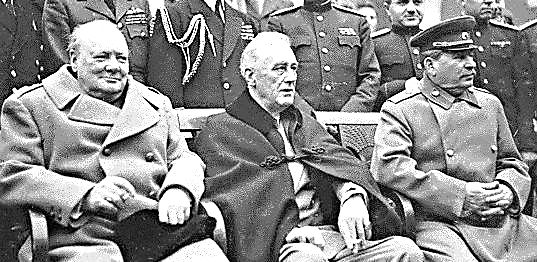 Churchill, Roosevelt and Stalin at Yalta
(National Archives)
Churchill, Roosevelt and Stalin at Yalta
(National Archives)
12 April 1945:
Warm Springs, Georgia. President Roosevelt dies of a cerebral hemorrhage. His Vice President, the relatively unknown Harry S. Truman, is sworn in as President.
7 May 1945:
Owase. The Fourth Special Attack (Tokko) Corps of the Yokosuka Naval District is formed at Owase harbor with 60 Shinyo explosive motor boats, 24 Kairyu midget submarines and four Kaiten human torpedoes. Rear Admiral Mito Hisashi (42) (former CO of KATORI) is appointed CO. Tender (ex-survey ship) KOMAHASHI is Mito’s flagship.
8 May 1945 - Victory in Europe (VE-Day):
Berlin, Germany. A week after Adolf Hitler commits suicide in his bunker, Germany surrenders to the Allied powers.
25 May 1945:
The Joint Chiefs of Staff issue a directive to Generals of the Army Douglas MacArthur, Henry H. Arnold and Fleet Admiral Chester Nimitz to proceed with the invasion of Japan.
 Japan
Japan
28 May 1945:
Operation “Downfall” is the two-phase plan for the invasion of Japan. On 1 November 1945, an amphibious assault, code-named Operation “Olympic”, will begin on the southernmost home island of Kyushu, followed about 1 March 1946 by Operation “Coronet”, the invasion of the main island of Honshu.
"Ketsu-Go"(Decisive Operation) is the Japanese plan for defeating the Allied invasion. Since the only beaches suitable for amphibious assaults are on Kyushu and the Kanto plain, south of Tokyo, Japanese intelligence correctly predicts the invasion will take place in southern Kyushu at Miyazaki, Ariake Bay and the Satsuma Peninsula.
The American landings at Kyushu will be opposed by 14 Japanese divisons, seven independent mixed brigades, three tank brigades and thousands of men of the Special Naval Landing Forces. On Kyushu alone, 790,000 mostly well dug-in Japanese with pre-registered weapons will oppose 550,000 American invaders.
May 1945:
Genkai Town, Saga Prefecture. Members of a Lt (j.g.) Kageyama’s 118th Shinyo Special Attack Squadron composed of 189 men and 25 boats prepare for the defense of Genkai. They lodge in storage caves, stone-cut huts, and private houses. The squadron trains day and night.
21 June 1945:
At 1700, Okinawa is declared secure.
June 1945:
Imperial Headquarters also expects that American forces will land in southern Shikoku to carry out the decisive battle for the Japan, so Army units are positioned along the coast of Tosa Bay and Navy special attack squadrons with Shinyo and Kaiten are positioned in key areas.
Kochi Prefecture, Shikoku. The 132nd Shinyo Special Attack Squadron is stationed at Tosashimizu on Koshi Bay in preparation for a landing by American forces. Of the squadron's 171 members, 48 are crewmen, mostly 17 years of age. The squadron’s 24 Shinyo motorboats are sheltered in 14 caves near the bay. Each of the shelters dug into the caves is about 3.5 meters high and wide and 20 to 29 meters in depth.
26 June 1945:
Kochi Prefecture. Lt Tatsuya Nakatani and 48 men of his 134th Shinyo Special Attack Squadron arrive at Kashiwajima island. They keep the squadron’s 24 Shinyo motorboats in six horizontal tunnels at the bottom of a hill in preparation for an expected invasion.
July 1945:
The IJN Special Attack (Suicide) Forces (Tokko Sentai) includes several corps with Shinyo boats, Kairyu submarines and land-based Kaiten manned torpedoes and is organized as follows:
Yokosuka Naval District:
• 1st Special Attack Corps under Rear Admiral Obayashi Sueo (former CO of HYUGA)(43) with 375 Shinyo, 210 Kairyu and 18 Kaiten.
• 4th Special Attack Corps under Rear Admiral (later Vice Admiral) Mito Hisashi (former CO of KATORI)(42) with 60 Shinyo, 24 Kairyu and 4 Kaiten.
• 7th Special Attack Corps under Rear Admiral Sugiura with 340 Shinyo, 36 Kairyu and 6 Kaiten.
Osaka Naval District:
• 6th Special Attack Corps under Rear Admiral Yokoi Tadao (former CO of CHIYODA)(44) with 50 Shinyo, 24 Kairyu and 4 Kaiten.
Kure Naval District:
• 8th Special Attack Corps with 225 Shinyo, 24 Kairyu and 32 Kaiten.
Sasebo Naval District:
• 3rd Special Attack Corps under Rear Admiral Shibuya Kiyomi (former CO of NAGATO)(45) with 275 Shinyo and 4 Kairyu.
• 5th Special Attack Corps under Rear Admiral Komazawa Katsumi (former CO of NISSHIN)(42) with 725 Shinyo, 24 Kairyus and 46 Kaiten.
 Hundreds of suicide motorboats in Japan ready for use
(National Archives)
Hundreds of suicide motorboats in Japan ready for use
(National Archives)
5 July 1945:
Less than three months after V-E Day, the United Kingdom holds a General Election. War-weary Britons oust Prime Minister Winston S. Churchill of the Conservative Party and replace him with Deputy Prime Minister Clement Atlee of the Labor Party that promises social reforms.
24 July 1945:
Potsdam, Germany, near Berlin. President Truman, Soviet Premier Stalin and new British Prime Minister Atlee attend the Potsdam (codenamed TERMINAL) Conference to discuss post-war Europe. Separately, Truman approves the plan for the invasion of Japan. The next day, Truman orders atomic bomb attacks on Japan to begin as soon as possible.
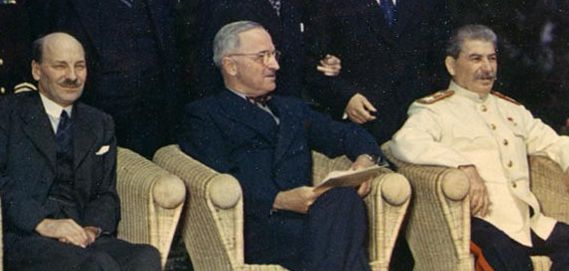 Atlee, Truman and Stalin at Potsdam
(National Archives)
Atlee, Truman and Stalin at Potsdam
(National Archives)
26 July 1945:
Potsdam. The Allies (United States, United Kingdom and China) broadcast the "Potsdam Declaration" that calls for the unconditional surrender of Japan, or the alternative of its prompt and "utter destruction". [1]
28 July 1945:
Tokyo. Prime Minister Admiral, the Baron, Suzuki Kantaro (14)(former CO of TSUKUBA) announces that Japan will ignore the Potsdam Declaration.
August 1945:
About 4,000 IJN "Shinyo" and IJA "Maru-ni" explosive motorboats (EMBs) are available in the home islands for defense against an Allied invasion. Shinyo bases are constructed at 114 places in Japan in well-concealed bases. The major Shinyo locations are at:
Honshu:
• Tokyo area (775 EMBs) -1st, 2nd, 3rd, 4th, 5th, 6th and 17th Shinyo Squadrons are deployed around
Sagami Bay to defend Tokyo.
• Chiba area -56th, 58th, 59th, 60th, 68th, 129th, 130th and 139th Shinyo Squadrons.
• Shimoda -57th Shinyo Squadron.
• Shizuoka -136th, 137th and 140th Shinyo Squadrons.
• Fukushima -141st Shinyo Squadron.
• Miyagi -146th Shinyo Squadron.
• Takayama -120th Shinyo Squadron.
• Tsukudajima -121st and 122nd Shinyo Squadrons.
Kyushu:
• Aburatsu area (125 EMBs) -54th, 117th and 126th Shinyo Squadrons.
• Kagoshima area (500 EMBs) -47th, 53rd, 61st, 63rd, 64th, 106th, 112th, 123rd,
124th, 125th,
130th, 135th and 138th Shinyo Squadrons.
• Hososhima (325 EMBs) -48th Shinyo Squadron.
• Nagasaki -62nd, 65th, 143rd and 144th Shinyo Squadrons.
• Amakusa -110th Shinyo Squadron.
• Oshima -111th Shinyo Squadron.
• Karatsu -118th Shinyo Squadron.
Shikoku:
• Kochi -49th, 50th, 128th and 132nd Shinyo Squadrons.
• Sukumo (50 EMBs) -134th and 142nd Shinyo Squadrons.
• Sunosaki -(175 EMBs).
• Tokushima -145th Shinyo Squadron.
32 other Shinyo bases are located outside of the Home Islands including:
Korea:
• Cheju-do (formerly Quelpart) Island -45th, 119th and 120th Shinyo Squadrons.
Formosa:
• Takao -20th, 21st, 29th and 31st Shinyo Squadrons.
Pescadore Islands:
• Mako -24th, 25th and 105th Shinyo Squadron.
China:
• Xiamen -108th and 113th Shinyo Squadrons.
• Zhoushan Islands (SE of Shanghai) -46th, 52nd 104th, 114th and 115th Shinyo Squadrons.
• Hainan Island -28th, 30th, 32nd, 33rd and 103rd Shinyo Squadrons.
Hong Kong:
• 35th, 36th, 37th and 107th Shinyo Squadrons.
Northern Borneo:
• Sandakan -6th Shinyo Squadron.
6 August 1945:
Japan continues to ignore the Potsdam Declaration. At 0815, Colonel (later Brig Gen) Paul W. Tibbetts, piloting a 509th Composite Group B-29 "Superfortress" named "ENOLA GAY" after his mother, drops the 15-kiloton yield "Little Boy" uranium atomic bomb on Hiroshima.
 Hiroshima.
(U.S.A.A.F.)
8 August 1945:
Hiroshima.
(U.S.A.A.F.)
8 August 1945:
Moscow declares that from 9 August 1945, the Soviet Government will consider itself to be at war with Japan.
9 August 1945:
Japan continues to ignore the Potsdam Declaration. At 1101, after abandoning the primary target of Kokura because of weather, Major (later Brig Gen, ANG) Charles W. Sweeney's B-29 "BOCKSCAR", of the 509th Composite Group's 393rd Bomb Squadron, drops the 21-kiloton yield "Fat Man" plutonium atomic bomb on the secondary target, Nagasaki.
 Nagasaki.
(U.S.A.A.F.)
That same day, as agreed by Stalin at Yalta, Soviet Far East Forces, comprising 80 divisions of 1.5 million men, invade Japanese-held Manchuria (Manchukuo). In less than two weeks, they defeat the Kwantung Army of over 600,000 men.
10 August 1945:
Nagasaki.
(U.S.A.A.F.)
That same day, as agreed by Stalin at Yalta, Soviet Far East Forces, comprising 80 divisions of 1.5 million men, invade Japanese-held Manchuria (Manchukuo). In less than two weeks, they defeat the Kwantung Army of over 600,000 men.
10 August 1945:
Fearing the next atomic bomb will completely obliterate Tokyo and the Imperial Palace, Japan offers to accept the Potsdam Declaration if Emperor Hirohito is allowed to remain head of state.
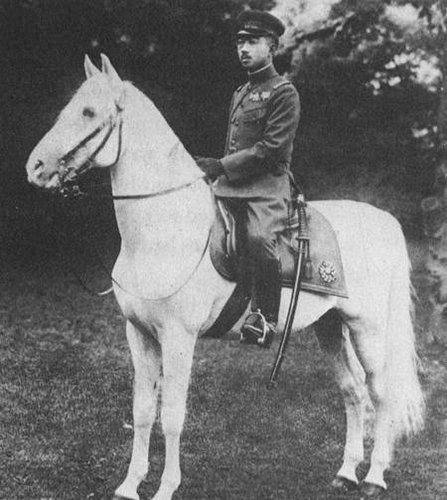 Emperor Hirohito (Showa) and Hatsuyuki (First Snow)
(Naional Archives)
12 August 1945:
Emperor Hirohito (Showa) and Hatsuyuki (First Snow)
(Naional Archives)
12 August 1945:
The United States announces it will accept the Japanese surrender and that the Emperor can remain in a ceremonial capacity.
14 August 1945:
Tokyo. At 1020, the Emperor convenes a conference of his most senior military officers. The Emperor notes that with the enemy's use of atomic weapons and Soviet entry into the Pacific War,
not even Onishi's Special Attack forces can stop them. Hirohito requests his senior officers to cooperate with him to end the war. Later, the Japanese announce the Emperor has decided to accept the Potsdam Declaration's terms and end the War, effective the following day.
15 August 1945: Cessation of Hostilities:
Imperial Palace, Tokyo. At noon, the Emperor announces Japan's surrender that is broadcast by radio all over the Japanese Empire.
16 August 1945:
Southern Shikoku. A rumor begins at Lt (j.g.) Aono's 128th Shinyo Squadron's base that, in spite of the previous day's announcement of Japan's surrender by the Emperor, an Allied task force is approaching Tosa Bay, apparently to invade. The squadron frantically prepares their EMBs for action, but a fire breaks out among the motor boats. A chain of warhead explosions follows that destroys 23 EMBs and kills 111 base workers, 23 shinyo crewmen and 3 officers of the squadron.
 (Monument to 128th SS's Pilots erected in 1976)
(Monument to 128th SS's Pilots erected in 1976)
2 September 1945: Formal Surrender Ceremonies:
Tokyo Bay. Japanese representatives arrive on board USS MISSOURI (BB-63) more than two weeks after
Japan accepted the Allies' terms. At 0905, Foreign Minister Shigemitsu Mamoru and General Umezu Yoshijiro, Chief of the Army General Staff, sign the Instrument of Surrender, followed by General of the Army, Douglas MacArthur, Supreme Commander for the Allied Forces, Fleet Admiral Chester A. Nimitz, representing the United States, and eight representatives of the Allied Forces.
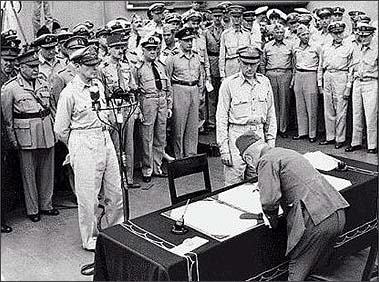 "..sign at the places indicated.."
(U.S. Navy)
June 1988:
"..sign at the places indicated.."
(U.S. Navy)
June 1988:
Pearl Harbor, Hawaii. Battleship USS MISSOURI is preserved as a museum at Ford Island.
 Plaque on the deck of the "Big Mo"
(Hackett collection)
With the War's end, Operation “Downfall” is cancelled. General of the Army George C. Marshall, CoS, U.S. Army, estimates up to one million casualties for the invasion of Japan, but a contemporary Army study estimates the invasion and subsequent Battle for Japan would have cost as many as four million American
casualties, including up to 800,000 fatalities, and five to ten million Japanese fatalities. If Downfall had become necessary, the Soviets most probably would have secured Hokkaido and invaded northern Honshu. This may have led to partitioning into North and South Japan, as occurred in Korea and persists to this day.
May 1984:
Plaque on the deck of the "Big Mo"
(Hackett collection)
With the War's end, Operation “Downfall” is cancelled. General of the Army George C. Marshall, CoS, U.S. Army, estimates up to one million casualties for the invasion of Japan, but a contemporary Army study estimates the invasion and subsequent Battle for Japan would have cost as many as four million American
casualties, including up to 800,000 fatalities, and five to ten million Japanese fatalities. If Downfall had become necessary, the Soviets most probably would have secured Hokkaido and invaded northern Honshu. This may have led to partitioning into North and South Japan, as occurred in Korea and persists to this day.
May 1984:
Genkai Town. Former 118th Shinyo Special Attack Squadron members erect a monument that contains a plaque listing the names of all 189 members of the squadron.
1987:
Odotsu, Nichinan City, Miyazaki Prefecture. A monument to the 117th Shinyo Special Attack Squadron is erected.
October 1988:
Otsuki Town, Kochi Prefecture. A monument to the 134th Shinyo Special Attack Squadron is erected.
March 1992:
Kyodomari, Nagasaki Prefecture. Minamikushiyama Town on Tachibana Bay. A monument to the Kyodomari Shinyo Special Attack Base and 65th Shinyo Squadron is erected.
March 2005:
Tosashimizu City. A monument to the 132nd Shinyo Special Attack Squadron is erected.
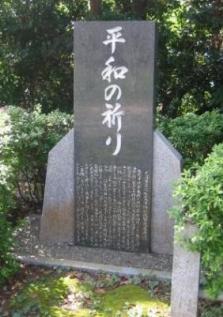
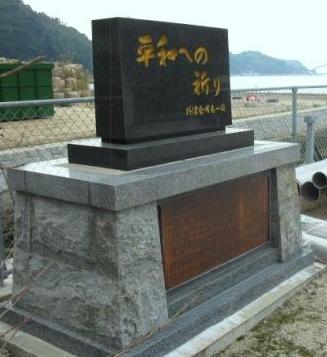
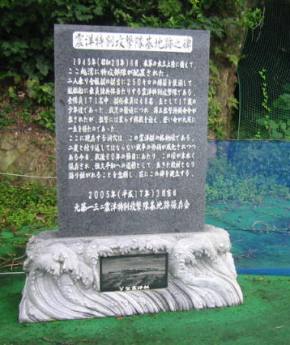

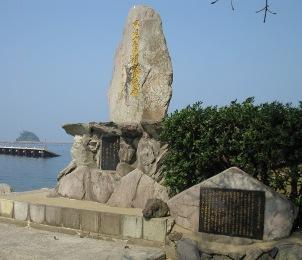 117th, 118th, 132nd, 134th and Kyodomari Shinyo Special Attack Squadrons' monuments
117th, 118th, 132nd, 134th and Kyodomari Shinyo Special Attack Squadrons' monuments
Authors' Notes:
[1] The Soviet Union was not a signatory to the Potsdam Declaration as they were not at war with Japan at the time.
-Bob Hackett and Sander Kingsepp
Back to Explosive Motorboats
Page



















